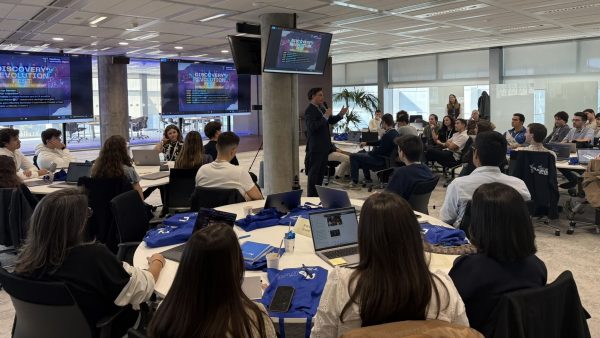Six years later it seems like nothing has changed. And I don’t just mean the fact that I am still or I should rather say once again devoting myself to this topic. Innovation and collaboration are still a necessary pairing, yet still presents us with challenges in day-to-day business. It is easier said than done to work together and tackle innovations together, when we are for instance all consumed by crammed calendars and have limited head space to look into anything outside our ever growing to-do list. And even in an ideal world where we have enough resources and capacities to innovate together, there is still room for misunderstandings based on different interpretation of what “innovation ” and “collaboration” actually means and entails.
Even the literature says so
According to my past-self “at the beginning innovation was simply related to what was perceived to be new to a company – but not necessarily new in general – over time characteristics like a more specific degree of novelty and the technological significance were added.” That lead to a variety of terms to differentiate types of innovation.
In the often quoted “The Innovator’s Dilemma” (2013), Christensen categorizes innovation into sustaining technologies, which improve existing valued products either in incremental, discontinuous or radical ways, and disruptive technologies, which occasionally emerge and underperform compared to current products.
This definition alone provides five terms that leave room for interpretation. The experts I interviewed for my thesis had slightly different explanations in mind for each term and individually added new aspects such as scalability or the user perspective. At the end of the day, the important thing is that your own definition and that of your organisation are clear, consistent and, in the best case, in harmony with each other.
It’s the same when it comes to collaboration and how we define it for ourselves. As pointed out in my thesis, companies typically start by identifying their target group and the potential methods of collaboration. For example, a company might collaborate with customers through joint product development, with academia via university partnerships, or with other businesses through accelerators, incubators, or industry roundtables.
Let’s bring it all together to make it more interesting and complex
The title of my thesis was ‘The Dilemma of Collaboration for Innovation’ for a reason. It’s a complex interplay, to say the least. The link between innovations and collaborative efforts has been researched, amongst others, by Fischer (2001), Stamm (2003, cited in Popadiuk & Choo, 2006), and Christensen (2003, 2013). According to them, collaboration can involve customers in some instances, while in others, it pertains to partnerships with other companies. But what about collaboration within an organisation?
It’s a necessity to make room for exchange to get a glimpse outside one’s own bubble. But “one’s own bubble” does not just refer to a company as such, but in many cases already to each individual business unit. Because let’s face it, innovation needs collaboration to happen. It’s always a team effort. And although this is something that resonates with everyone, we are often struggling to do this outside of our direct team structures and across business units. In fact, the bigger the corporate, the more independent the business units act. Which leads to impressive innovative efforts in each of the pillars, but also redundancies that could have been avoided if they would have collaborated with each other. – Quite a fatal situation, especially in times of tight budgets and scarce resources.
Eventually, the way I look at the interplay of innovation and collaboration since my initial research back in 2018 has changed in another main aspect: the necessary pairing of innovation and collaboration became a powerful triad. Transparency is now also included in the picture and equally important. In short, collaboration needs transparency, just as much as innovation needs collaboration to happen in the first place. It is therewith also one main focus of our Corporate Innovation work at Telefónica Germany. Let me explain to you how and why.
(Fun fact: To my own surprise not once did I actually use the term “transparency” in my thesis.)
Our business is to make innovation everyone’s business
But first, let’s go back a bit more than a year ago, when the corporate innovation department was founded. This was done to face the following two challenges, amongst others:
(1) Meet the strong demand for more collaboration between all business units
(2) Increase cross-divisional transparency about all innovation related information, such as innovation activities.
As you can already see, our mission is not to be the only place for innovation in the company. Because each business unit already has teams dedicated to innovative products and exciting new business areas. However, they are mainly working on their own and hardly ever together. This is exactly as described in the literature and no surprise that also for us it leads to duplication of work and inefficiencies. It is therefore our mission to break through the silo structures and to think innovation across business areas and eventually make innovation everyone’s business. Because as mentioned before: Innovation needs collaboration.
First thing we did when we started was to define the term “Innovation” for us as an organization. As I mentioned before, being coherent in what we mean with innovation, on company-, team- and individual level alike, is the starting point for innovation collaboration.
We decided to distinguish between the following three types of innovation: incremental, new-to-the-company and visionary:
- Incremental innovation describes the optimisation of a process, by using a different approach with current technologies. The offering (a product or service) already exists and the technologies and business logic is the same, but the processes behind has been improved or renewed completely.
- New-to-the-company innovation refers to new processes and business models, or the usage of future technologies. The value proposition and the customer group remain the same, but the way we do things, the business logic and/or technology behind it is new.
- Visionary innovation to us describes anything that goes beyond the existing. The emphasis is on “us” in that regard. What’s visionary in our context might be incremental for another organisation. But for us it means we introduce a new value proposition to our customers, and/or address a completely new customer group with a new business logic and or new technology.
Once the definition was agreed upon, the next step for us was to think about the necessary corporate wide infrastructure to create transparency which eventually will enable collaboration.
One platform to inform them all
What if there was a place where all business units and functional areas could come together, visualize their innovation work and interact with each other? – That’s when our Innovation Platform enters the room. Introduced to serve as a go-to-hub for all innovation-related information at Telefónica and therewith fosters transparency among all our business units, while at the same time allows for interaction and connection between all users and therewith fosters collaboration.
The range of information provided on the platform goes from activities (projects) from each business units, to new ideas derived from tailored innovation campaigns, micro and macro trends, technologies, to Start-ups from our internal ecosystem and internal experts. What makes this comprehensive amount of data and knowledge even more powerful is the fact, that each piece of information can be connected and put into relation with each other. This allows different use cases to be covered and makes it easier to search and filter for topics. So eventually the platform makes room for exchange to get a glimpse outside one’s own bubble. And “one’s own bubble” in fact referring to each individual business unit but also the company as such. Two in one.

Fig.2 Roughly two months after launch there are already over 1300 unique pieces of information on the Innovation Platform
Although the platform allows for interaction, as I just mentioned, it is rather just a starting point for it. In-depth discussion and exchange need more space.
One community to connect them all
Yes, using communities as an important vehicle to promote collaboration within a company is nothing new. But done right, it can be very effective.
Our Innovation Community serves as a dynamic and inclusive space and is designed to bring people together from different backgrounds, roles and hierarchies. The aim is to jointly explore, inspire and drive innovation. The community is explicitly open to all employees and therewith promotes a broad spectrum of perspectives and eventually the aspired cross-company collaboration.
We have opened a virtual Teams space which is our basis for the community work. An important aspect here is that while the community is filled with relevant content from our Innovation Platform (e.g. successfully completed projects, special cross-company initiatives, notable internal experts) through us as community initiators, it not only serves as an extended information medium for corporate innovation. It should rather be perceived and used by all members as a space for knowledge exchange in which open questions can be asked and discussions initiated. Which they actually do. In July alone we had an activity rate of 68%, i.e. community members who either started a discussion themselves or interacted with content from others.
However, to fulfill the purpose of exploring, inspiring and driving innovation, it is not enough to focus on internal knowledge. As mentioned before and as you can imagine already, it is equally important to look outside our company bubble. Even more so, when our day-to-day life doesn’t allow for much external inspiration in general.
One way of ensuring a balanced infusion of external impulses and internal knowledge into the community, is via regular Innovation Community Events. Based on trends that have been derived from our 360 Trend Radar (not going into detail about the trend radar here, that’s for another blogpost) and voted upon amongst our community members, we defined three different ways of tackling a topic. First, we ask ourselves the following three questions:
- Do we want to showcase what we already do or plan in relation to the trend topic?
- Do we want to look outside of the box and gain insights on how others already tackle the trend topic?
- Do we want to think ahead to a potential future scenario?
Each approach is related to a specific content piece and a variety of possible on-site, virtual or hybrid formats. The underlying goal for us is to reach as many interested colleagues as possible with meaningful content and spark a discussion that eventually leads to cross-company collaboration. Full circle.

Fig. 3 Starting point for each Innovation Community Event
This is just the start
If you made it this far, I hope you won’t be disappointed with my conclusion of “this is not a sprint, it’s a marathon”. Because it is. In fact, I think the journey we are currently going through can be characterized by three things:
- It’s complex: Creating transparency, that enables cross-company collaboration and eventually fosters innovation truly requires a shared understanding of what we do and what we try to achieve, as well as the necessary structures to get there. In a company with over 7000 employees that is easier said than done.
- It’s a process: Change doesn’t happen overnight. It is a continuous process, requiring ongoing effort but also learning and reflection, to adapt when needed.
- There is no “one solution fits all”: I’ve worked for a few big corporates and they certainly have a things in common (complex decision structures and evolved processes to name two obvious ones), but at the same time each organization has a unique culture and goals which needs to be acknowledged and taken into account when striving for more efficient innovation.
The Innovation Platform and the Innovation Community are currently the two main vehicles for us to start making innovation everyone’s business at o2 Telefónica, to unleash the potential of transparency and collaboration for more efficient innovation. Especially in times of tight budgets and scarce resources, that’s more important than ever. But one thing’s for sure: It won’t just be the two of them in the long run. Happy to keep you in the loop on our marathon.








